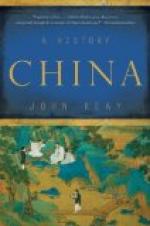But the production of military colonies was still not enough to feed the armies, and the government in Chu’s time resorted to a new design. It promised to give merchants who transported grain from Central China to the borders, government salt certificates. Upon the receipt, the merchants could acquire a certain amount of salt and sell it with high profits. Soon, these merchants began to invest some of their capital in local land which was naturally cheap. They then attracted farmers from their home countries as tenants. The rent of the tenants, paid in form of grain, was then sold to the army, and the merchant’s gains increased. Tenants could easily be found: the density of population in the Yangtze plains had further increased since the Sung time. This system of merchant colonization did not last long, because soon, in order to curb the profits of the merchants, money was given instead of salt certificates, and the merchants lost interest in grain transports. Thus, grain prices along the frontiers rose and the effectiveness of the armies was diminished.
Although the history of Chinese agriculture is as yet only partially known, a number of changes in this field, which began to show up from Sung time on, seem to have produced an “agricultural revolution” in Ming time. We have already mentioned the Sung attempts to increase production near the big cities by deep-lying fields, cultivation on and in lakes. At the same time, there was an increase in cultivation of mountain slopes by terracing and by distributing water over the terraces in balanced systems. New irrigation machines, especially the so-called Persian wheel, were introduced in the Ming time. Perhaps the most important innovation, however, was the introduction of rice from Indo-China’s kingdom Champa in 1012 into Fukien from where it soon spread. This rice had three advantages over ordinary Chinese rice: it was drought-resistant and could, therefore, be planted in areas with poor or even no irrigation. It had a great productivity, and it could be sown very early in the year. At first it had the disadvantage that it had a vegetation period of a hundred days. But soon, the Chinese developed a quick-growing Champa




